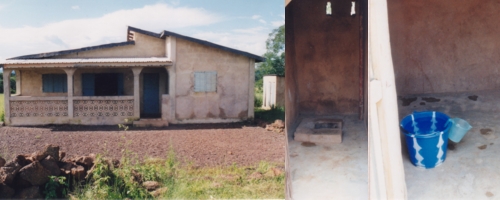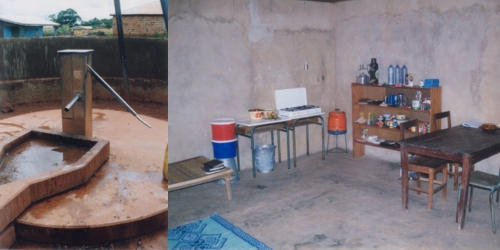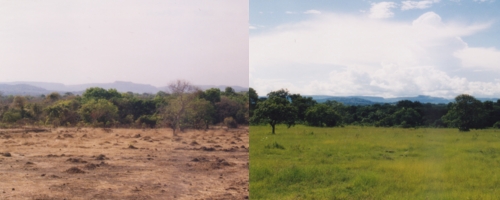For background, I am describing some of my experiences from the US Peace Corps in Guinea, West Africa. More information on this series is available in the introduction. Many often wonder what it is really like to live as a Peace Corps Volunteer. The fact is it can be a very different experience depending on which country and what position you are posted to. It has also changed significantly from the days in the early 1960s to the present, partly due to worldwide development, and partly due to changes in the Peace Corps methods and objectives. So, while every experience will be different from what I describe, this article will offer one perspective on what it was like for me serving in one place in the nation of Guinea from 1998 to 2000.
So, What Was It Like ... ?
Upon my return to the United States from my Peace Corps service, I was acosted with this vague generality of a question on many occaisions. At the time, having been fully immersed in another culture for two entire years, I was left as dumbfounded as if an alien had appeared at my front door and asked me why I lived on Earth. Over time, I saw that it was just the question from ignorance, someone not knowing anything about what my life had actually been like those two years and wanting to appear interested.
So, this article will cover the details about what my life was like day to day. Not about the purposes of my service or the outcomes, but where I got my food and water and dealt with other necessities.
Shelter and Amenities
I lived in a fairly large house (3 bedrooms, living room, 2 storerooms, covered porch) built out of concrete blocks and a corrugated steel roof. I lived there alone. There was no running water or electricity or telecommunications. The "bathroom" was a latrine, the same concrete construction over a very deep hole in the ground. For showers, I had a bucket full of water (sometimes warmed with a kettle of hot water from the gas stove) and a large cup with a handle. Over time I learned to bathe with no more than 10 liters of water. Conservation was important due to the amount of effort to get water to my house. While I sometimes paid a neighbor boy to bring water, I often did the job myself carrying 20 liters at a time [20 kg or 44 lbs] the roughly 150 meters between the nearest hand pump and my house. I averaged a usage rate of about 20 liters a day for cleaning, drinking, cooking, and bathing.
 I cooked dinner for myself (and sometimes breakfast) fairly often using a propane stove in a "kitchen" made out of a corner of my living room. Other than the propane stove, my home was similar to those of other families who had a government-employed salaried worker. My furniture consisted of some bamboo chairs, queen-sized beds with straw or foam mattresses, wood tables, and chairs, and bookshelves.
I cooked dinner for myself (and sometimes breakfast) fairly often using a propane stove in a "kitchen" made out of a corner of my living room. Other than the propane stove, my home was similar to those of other families who had a government-employed salaried worker. My furniture consisted of some bamboo chairs, queen-sized beds with straw or foam mattresses, wood tables, and chairs, and bookshelves.
 Candles and kerosene lamps provided light in the evenings while I was cooking and eating, listening to the radio, reading, or working on lesson plans or grading papers.
Candles and kerosene lamps provided light in the evenings while I was cooking and eating, listening to the radio, reading, or working on lesson plans or grading papers.
Food
The traditional food in Guinea is rice and sauce. The sauce varied between maffe tiga , peanut sauce, usually beef and onions and tomatoes in a sauce made from ground peanuts; maffe hakko, leaf sauce, usually made from cassava or sweet potato leaves and dried or smoked fish; maffe takko, okra sauce, similar to leaf sauce but using pounded okra in place of leaves; and maffe soupo, a tomato based sauce including potatoes and beef and eggplant. If interested, you can find some recipes here. Most days, I would buy a lunch of rice and sauce at a small "restaurant" (nothing more than a woman with a few pots of hot food, a bench, and a table) in the center of my little town for about 35 cents. Ground red pepper would be dusted liberally on the meal by those wanting some kick. [ad name="Adsense Small Horz Banner"] For other meals, I would cook soups, stews, and pasta at home piecing together groups of different vegetables I would find in the market. Canned tuna and fresh eggs either boiled or fried would make up some wonderful sandwiches when paired with the hot, fresh, french baguettes baked in wood fired ovens I could buy in the market almost every day. My breakfasts were usually hot tea or instant coffee along with some fruit preserves on a few pieces of baguette saved from the prior evening.
Weather
Living in the tropics for two years means rewriting your ideas of seasons. Instead of the temperate pattern of cold then mild and wet then hot then mild and dry then cold again, one faces warm and humid with near daily rain showers, then cool and dry, then very hot and dry, then back to the rainy season again. Having grown up in southeast Texas, the weather was no more extreme than I was used to, but living without air conditioning or even glass on the windows makes the weather a much more real participant in your life with whom you have to negotiate. Waking and sleeping, bathing, washing, reading, visiting friends, cooking, working, and studying are all affected by what the weather chooses to do. Rather than fight it, you find yourself learning to pace yourself by what the sun and clouds do. The pictures below show the view from my house during the rainy and dry seasons.
 Travel
[ad name="Peace Corps In Line Banner"]
I was not at my post 100% of the time. Several business reasons forced me to be away generally 3-4 days out of every 4-6 week period. One of those was going to collect my Peace Corps living allowance at the bank. Other meetings with the Peace Corps administration, other volunteers, training activities, and shopping for needed items in larger cities provided the other reasons. Sometimes by bicycle, but usually by bush taxi (overcrowded station wagon) I would travel from my post to the regional capital or national capital for business. These "breaks from village life" provided needed social time, communications with family back in the states, and more interesting food.
Travel
[ad name="Peace Corps In Line Banner"]
I was not at my post 100% of the time. Several business reasons forced me to be away generally 3-4 days out of every 4-6 week period. One of those was going to collect my Peace Corps living allowance at the bank. Other meetings with the Peace Corps administration, other volunteers, training activities, and shopping for needed items in larger cities provided the other reasons. Sometimes by bicycle, but usually by bush taxi (overcrowded station wagon) I would travel from my post to the regional capital or national capital for business. These "breaks from village life" provided needed social time, communications with family back in the states, and more interesting food.
So, while not comprehensive, for me, these things made up a little slice of what it was like to physically live in Kankalabe, Guinea.
